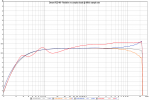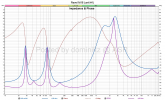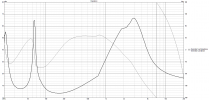solderdude
Grand Contributor
If the output impedance is essentially zero at 3 kHz how can the 0.2dBr difference between the 4 Ohm and 8 Ohm measurement be explained?
Can you calculate once for me how big the frequency response deviation is, for example at 3kHz, if the 4 Ohm and 8 Ohm measurement shows 0.2dBr difference and the speaker has 60 Ohm impedance at 3kHz?
At 3kHz I arrive at (around) 0.2ohm output R (higher at higher frequencies of course) so DF of 20 for 4ohm and DF of 40 for 8ohm at 3kHz.
A bit higher DF below 1kHz.
Note: the slightly lower output voltage may come from the used output inductor (DC resistance), feedback topology/point, PCB traces or wiring to the output so the above calculations may not be accurate but will probably in the ballpark for this amp at the given frequencies.
Last edited:



